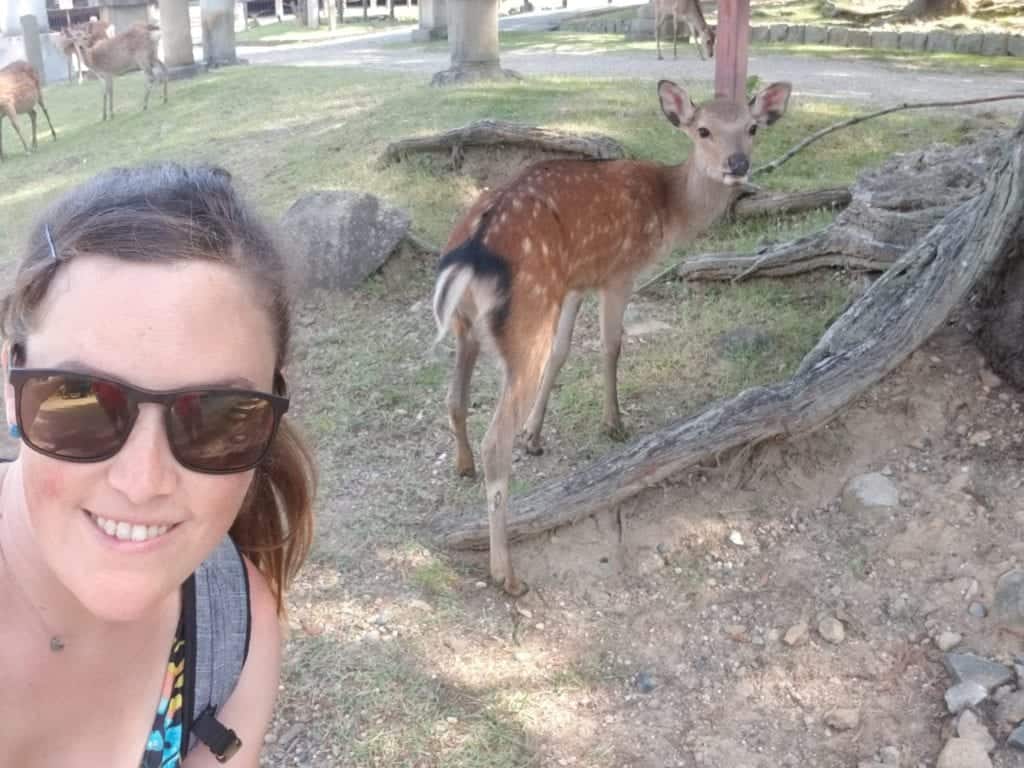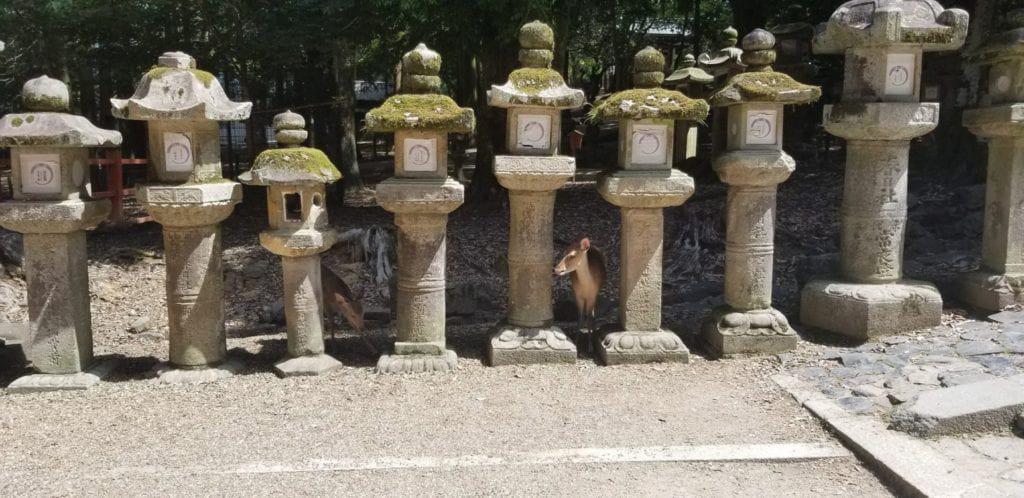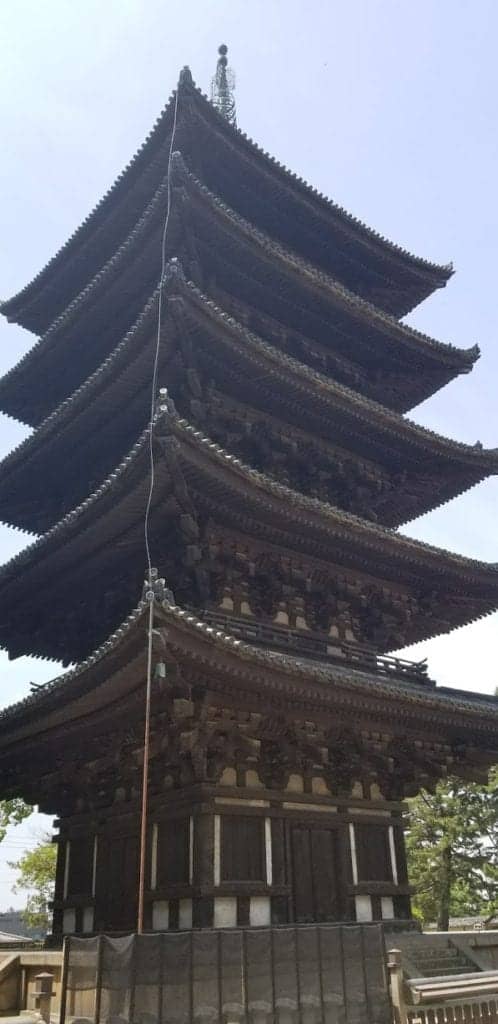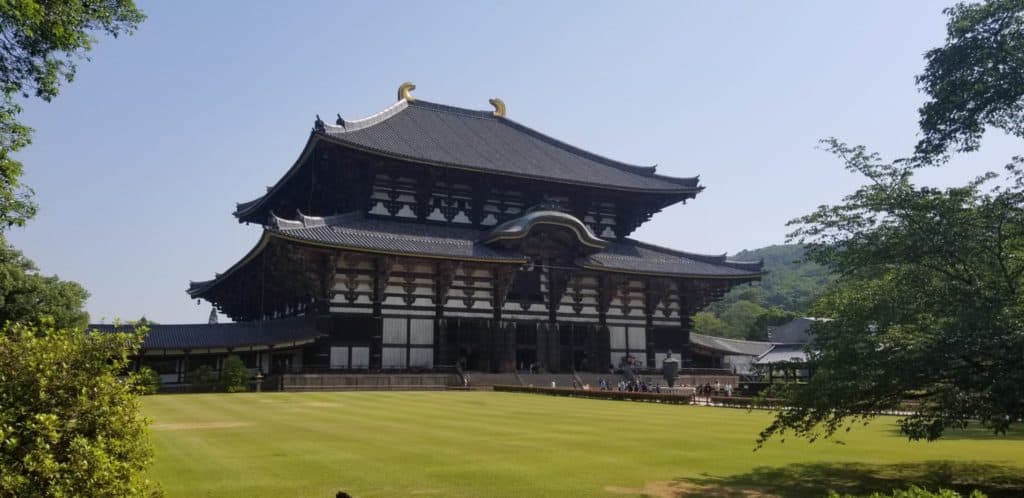Nara is not just for the deer! A quick hour train ride from either Kyoto or Osaka, if you love history, you want to spend at least a full day in Nara. A weekend is better! Especially if you are like me and want to tick off all the UNESCO World Heritage sites. The capital city of Nara Prefecture, Nara was the capital of Japan before the emperor moved to Kyoto in the late 8th century by way of Nagaoka for 10 years.
- Real Quick History: Why isn’t it still the capital?
- UNESCO Historic Monuments of Ancient Nara and National Treasures
- 1. 元興寺 (Gangō-ji, Gango Temple)
- 2. 平城宮 (Heijō-kyū, Heijō Palace)
- 3. 春日大社 (Kasuga-taisha, Kasuga Grand Shine)
- 4. 春日山原始林 (Kasugayamagenshirin, Kasugayama Primeval Forest)
- 5. 興福寺 (Kōfuku-ji, Kofuku Temple)
- 6. 東大寺 (Tōdai-ji, Eastern Great Temple)
- 7. 唐招提寺 (Tōshōdai-ji, Toshodai Temple)
- 8. 薬師寺 (Yakushi-ji, Yakushi Temple)
- 9. Nara Park (奈良公園, Nara Kōen) and the deer!
- 10. Witness the deer calling
- 11. Nara in Autumn?
- 12. Try some local beer
- How to get to Nara
- Where to stay?
- Slowing Down Time
- Utilize the Tourism Center
- Pin this for later

Real Quick History: Why isn’t it still the capital?
The Nara Period lasted less than a 100 years thanks to all of the Buddhist Temples I’m about to tell you about. Nara, or as it was known then Heijō-kyō (平城京), was designated the capital of Japan in 710. Or more so the capital was moved there. You can thank Empress Genmei for that, the 43rd ruler of the Chrysanthemum Throne. Yes, I said empress.
As the temples grew, they quickly started to have way to much political influence for the royal families liking. So they moved! I think one of the more interesting pieces of this cute little town – minus the deer, of course.
Disclosure: Kristenabroad.com is a participant in the Amazon Services LLC Associates Program, an affiliate advertising program in which I may earn a small commission by linking to Amazon.com and affiliated sites. The price to you is not affected!
UNESCO Historic Monuments of Ancient Nara and National Treasures
You can’t talk about Nara and not talk about UNESCO world heritage sites! It’s actually collectively as a whole a UNESCO Site and consists of eight location which should be on your must see list while here. These are further designated by the Japanese government to include 26 buildings that are National Treasures and over 50 important Cultural properties!
If you like historical buildings, Nara is your place.
1. 元興寺 (Gangō-ji, Gango Temple)
Fun fact. When the capital was moved to Nara, so was this temple! It was originally called Asaku-dera or Hoku-ji. With the move, came a new name. As they say on their website “the place where the first Buddhist temple was built”. The origin temple. One of the oldest, if not THE oldest Buddhist temple in Japan.
2. 平城宮 (Heijō-kyū, Heijō Palace)
The Heijo Palace was the imperial palace during the Nara Period. It was abandoned when they moved the capital way from Nara. There has been extensive excavation work and you can see the reconstruction of the main gate.
3. 春日大社 (Kasuga-taisha, Kasuga Grand Shine)
Ah, our only Shinto shrine in the mix! There are 3,000 分社 (bunsho, branch shrines) around Japan for Kasuga taisha according to their website. That’s a big deal, it means people really like this kami or god. The branch shrine is an important concept in shintoism coming from Bunrei 分霊 which means “seperate spirit”. The main shrine houses the “original” kami or god. Then there are other smaller shrines that same kami, with the same powers. There’s always a distinction for the main shrine though!
The shrine also has around the same amount of lanterns leading up to it.

4. 春日山原始林 (Kasugayamagenshirin,
Kasugayama Primeval Forest)
Located right at Kasuga-taisha is an ancient forest which has remained untouched since the 9th century! How? Apparently they banned logging and hunting in it. If you didn’t get enough exercise from just walking around Nara Park (more on that in a minute) and all of these sites, you can enjoy a hike up the mountain!
The trail is 11.5 km so make sure you’ve got some water with you. No vending machines this way! (Yes, you can find them on hikes sometimes!) .
I love my camelbak insert that I can fill as needed on my day pack!
5. 興福寺 (Kōfuku-ji, Kofuku Temple)
Elegantly in English “the temple that generates blessings”, Kofukuji has been in it’s present location since the 700s. It is one of the two head temples of the Hosso Sect of Buddhism. Four of it’s buildings have been designated National Treasures and two are Important Cultural Properties. My favorite is probably the five story pagoda.

6. 東大寺 (Tōdai-ji, Eastern Great Temple)

Todai-ji (東大寺) was constructed in 752 as the head temple of all provincial Buddhist temples of Japan. This building is literally why Nara is no longer the capital. The temple had way too much influence on government affairs!
While there are many websites claiming that Daibutsuden (Big Buddha Hall) is the world’s largest wooden building, Guiness doesn’t back that up. Regardless, the present 1692 reconstruction at two thirds of the original temple hall’s size is impressive.
Make sure to check out one of Japan’s largest bronze statues of Buddha (大仏, Daibutsu).
7. 唐招提寺 (Tōshōdai-ji, Toshodai Temple)
You will need to take a bus to get to this one, it’s not as central as most or you can walk from the last one I’ll tell you about. While it doesn’t have as many subsidiary temples anymore (that always seems like a franchise to me), they somehow still own 17 National Treasures and more than 200 Important Cultural Properties!!!
8. 薬師寺 (Yakushi-ji, Yakushi Temple)
I left the far ones for last, this is easiest to get to by train. Nishinokyo Station is about 20 minutes from Kintetsu Nara Station and then it’s a quick walk. It’s another that moved when the capital moved. Did you know they did the same thing with castles sometimes? It just amazes me the engineering feat it must have been to pull something off like that!
9. Nara Park (奈良公園, Nara Kōen) and the deer!
Nara Park holds the claim to being one of the oldest parks in Japan. It also has been designated as one of the “Places of Scenic Beauty” by the Ministry of Education, Culture, Sports, Science and Technology (MEXT or more cutely Monka-sho, 文部科学省, Monbu-kagaku-shō).
Get our your walking shoes as the park is well over 1,000 acres. The best part? Hanging out with the 1,400 or so wild sika (シカ or 鹿 shika, deer) ! They are considered sacred and it use to be punishable by death if you killed one. Now, they are designated as national treasures and you can feed them special deer crackers (鹿煎餅 Shika-senbei).
10. Witness the deer calling
Shikayose (鹿寄せ) happens in the winter and summer. 寄せ (yose) can mean “to gather” but it can also mean “last move” in a game of go or chess. So the event is a “deer gathering” but if you consider the alternative meaning, it’s funny to think of it like some crazy video game where the deer come out from the woodwork.
How do they get gathered? A french horn playing Beethoven’s 6th Symphony of all things! It takes place in the morning near the Nara National Museum. Remember, I absolutely adore Japan’s tourism information, and you can check out dates and times there.
11. Nara in Autumn?
If you aren’t around for the deer calling, you may be for another special deer event! In Autumn since the Edo period, the antlers are ritualistically cut to keep the deer safe from each other. (And probably doesn’t hurt the people factor). It’s rather morbidly called 鹿の 角切り (shika kakugiri) or deer dicing.
12. Try some local beer
Have we met? I always try the local beer when I’m out exploring! Naramachi Brewery is located to the west side of the park but you can also find it places throughout the city, like Sakura Burger.
How to get to Nara
From Tokyo, you can either fly or take the shinkansen. I prefer the train as you’ll want to do some jumping around the surrounding area as well. It’s easiest to combine with a trip to Osaka or Kyoto, if you are doing the “main circuit” as I like to call it.
Where to stay?
While you could stay in Kyoto, I’d suggest saying local so you really get your deer loving in and send a few days in Nara. With all of the world heritage sites, there’s definitely enough to keep you busy!
Booking.comIf you go for the centralized plan of one of the bigger cities, personally, I’m a huge fan of APA hotels (pronounced how it’s spelt, not as an acronym). They are fairly inexpensive (yes, that means small rooms), normally situated near the train station, and a lot of times has a public bath.
Slowing Down Time
The best part about a trip like this? And perhaps even my favorite part about travel, regardless of the place, is the more you fit in, the longer it appears to your brain you’ve been gone (More on that in Moonwalking with Einstein, it’s definitely true). Hitting Nara for a weekend trip could feel like weeks!
Utilize the Tourism Center
Nara City has one of the best tourism websites in English I’ve seen. They even have a 50 page “brochure”, that may as well be a book that you can download for free. If you need some further tips, check out this guide on how to research a trip to Japan.
Pin this for later

